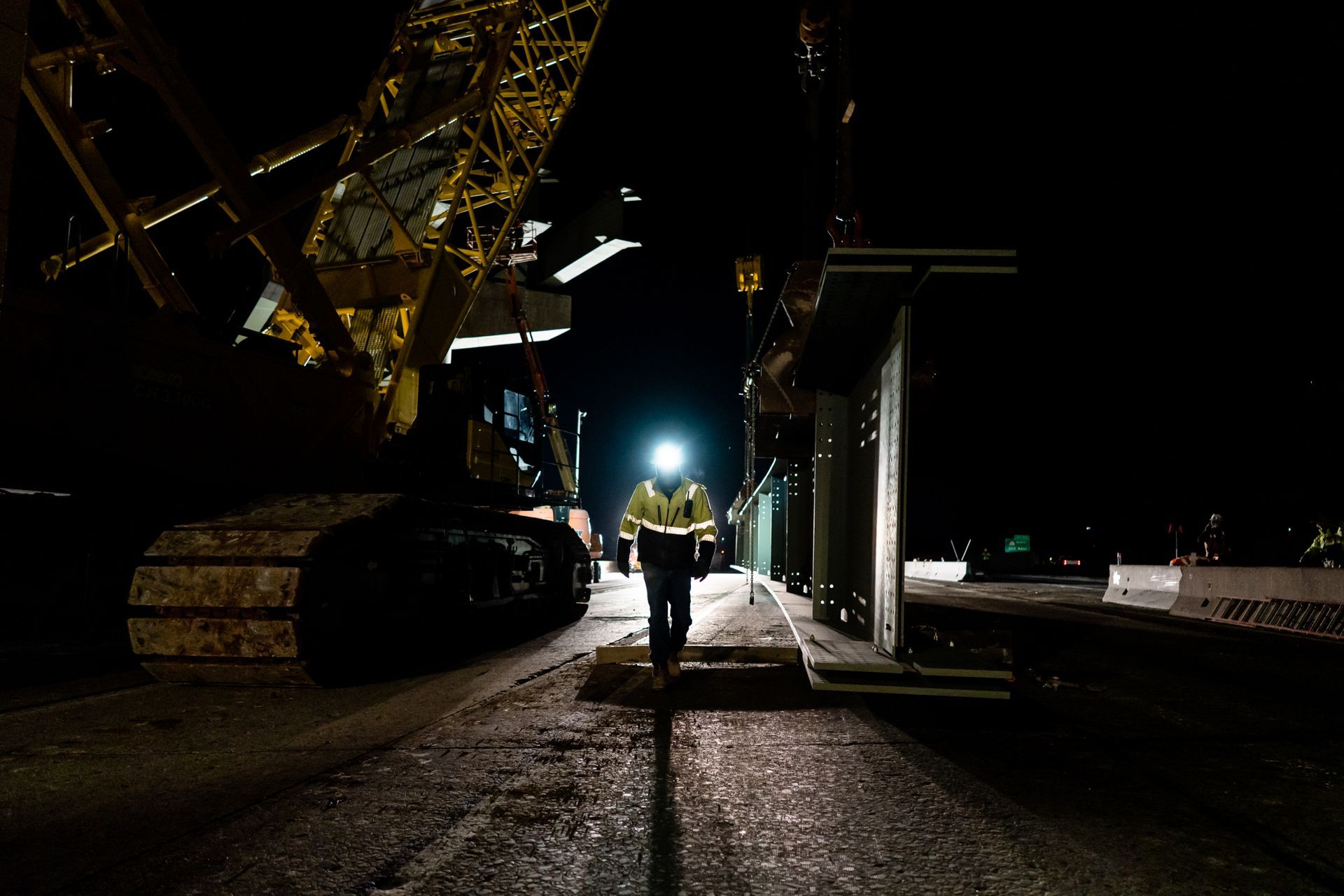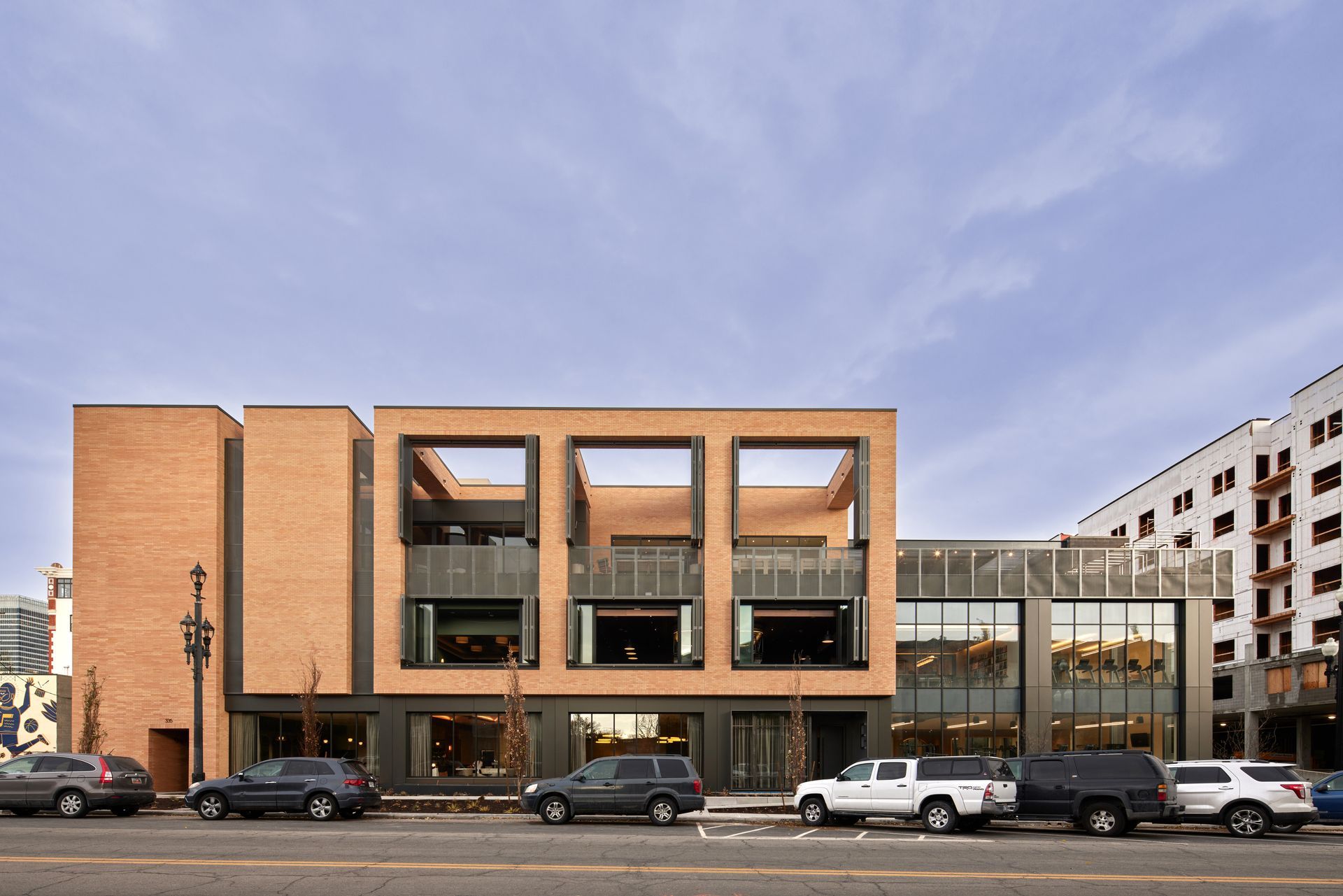Perfect Calling
The face of Utah's AGC chapter for four decades, Rich Thorn's positive impact on Utah's construction industry has been nothing short of legendary.
Capitalizing on his family’s good name—and his own gregarious, optimistic nature and personal charm—Rich Thorn has been among the most prominent advocates of Utah’s construction industry for more than 40 years.
As the President/CEO of the Associated General Contractors (AGC) of Utah, Thorn has been the proverbial face of the association since assuming the title of its top executive in October 1982—just before reaching 25 years of age. It has proven to be a role tailor-made to his
skills, education, and upbringing.
“Every day is a great day,” Thorn exclaimed during an early February phone call to discuss how he was feeling after AGC of Utah’s 100th-anniversary convention. Besides it being the coveted century mark in time, this year's event was particularly special to Thorn due to the remarkable turnout and energy level of those who attended.
“Our numbers [of attendees] were above those of pre-Covid numbers, and couple that with the companies who were sponsors, we were really happy with the turnout,” he said.
It was also significant in that it was his second-to-last AGC convention, as Thorn, 65, recently announced his retirement, effective at the end of the state’s legislative session in March 2023.
“I’d be less than honest if I didn’t feel some bit of nostalgia,” he said. “This is the next to last one; there is a lot of sentimental value, as I’ve been through a lot of these.”
Over the past couple of years, Thorn has been gradually handing over the reins of the chapter to long-time AGC of Utah Vice President Joey Gilbert, with Melissa Camp, Director of Finance and Administration, also filling a vital staff role. Gilbert and Camp were hired in 1997 and 2003, respectively, and have more than 40 years combined experience, yet are acutely aware it’s going to be challenging filling Thorn’s shoes.
“He’s the eternal optimist, liked by everyone,” said Gilbert, trying to sum up Thorn’s character in a few words. “He’s always upbeat and treats everyone like a best friend. I get that comment all the time.”
“I’ve been trying to convince him not to leave,” laughed Camp. “He cares—that’s the biggest thing. And cares not just professionally, but about your personal life. We’re calling this his ‘farewell tour.’ It’s hard for him 100% to step back, but he’s trying. He’s trying to take it all in and enjoy it.”
Ideal Upbringing included Construction and Politics
A native of Springville, a relatively small Utah town with a rich history of heavy/civil contractors, Thorn was born into a prominent construction family. Great-grandfather Ashel O. Thorn started Thorn Construction in the 1920s, with grandfather Paul Thorn (AGC of Utah President in 1947) and great-uncle Grant Thorn also running the firm for many years, before it closed in 1981.
His father, James (Jim) Thorn, worked at the company for many years as a laborer, heavy equipment operator, foreman, and superintendent/project manager. Fond memories from Rich’s youth include staying at motels during the summer in towns like Orderville in southern Utah and Delle in Utah’s west desert, while Jim managed paving jobs.
Thorn spent summers in high school and college working at Thorn Construction, learning how to operate loaders, dozers, and asphalt pavers—great hands-on experience of what happens in the field.
“For me, that’s always been helpful because I can relate to what that’s like,” he said. “I will never forget the guy wallowing in the mud, laying pipe, making it happen on the job site. That’s where the work gets done.”
One powerful early memory came via a job site visit with Grandpa Paul, on a day with rather inclement weather.
“It was a lousy, rainy, bad day,” Thorn recalled. “We pulled onto the job and Grandpa Paul was the executive. He was wearing brand new Florsheim shoes. He got out of the car and walked through the mud to shake the ‘Cat skinner’s hand. I will never forget that. He saw the value of the people he worked with, and that’s the term, he worked with them. The Thorn name meant a lot in the construction industry; our company had a good reputation.”
On the flip side, his mother, Karen, was perhaps even more influential on Thorn, given her vast political clout and lengthy career that included working for two U.S. Congressmen and two U.S. Senators for 35 combined years, in addition to serving on multiple community and political organizations. She was sharp, with an infectious smile and a keen ability to connect with people of all persuasions.
Karen’s career included working in Washington D.C., which uprooted the family from tiny Springville and had them living in the nation’s capital from 1961–1964, Thorn’s first three years in elementary school.
The experience was magical for young Rich, with “family field trips” most weekends to different historical U.S. sites. He’s been to D.C. dozens of times throughout his professional adult life. He cites D.C. as perhaps his favorite city.
“He’s his mother, through and through,” said Thorn’s wife of 43 years, Sherrie. “He’s got his dad’s [gift of gab] skills—he likes to talk—but he’s got his mom’s kindness. His mom was just genuine.”
Karen’s ties helped Thorn effectively navigate Utah’s political waters at an early age, and his 40 years of lobbying on Utah’s Capitol Hill has been consistent and effective, year after year. He’s been resigning from various labor and pension boards and other workforce and industry committees (upwards of 15-plus during peak years) while having Gilbert step in to fill the void.
“It’s all part of the plan,” Thorn said. “It’s flattering to be called by the Governor to serve on a board or as a chair of a committee. I feel obligated to serve and I’ll give it my best. It’s nice to have people ask for your opinion.”
Thorn remains engaged in this year’s legislative session, having been to Capitol Hill three times, and is reading legislation, giving input, and suggesting amendments while Gilbert is running point.
“I’m up there as his wingman,” said Thorn. “We talk every day. That’s part of the [transition] process. It’s been a bit of a learning curve for me to sit back.”
Family First
Thorn said the single greatest benefit of working for the AGC, for himself and Sherrie, was being able to comfortably raise their family of four children. They met at Dixie College in 1976—Thorn was on scholarship playing football and baseball—and married in June 1978.
In the fall of 1980, he got wind of a staff assistant position at AGC of Utah and was hired to work under Horace (Hod) Gunn on September 15. It proved to be a great fit, with Thorn’s construction background and jovial nature making him an instant asset to the association. When Gunn announced his retirement less than two years later, both Thorn and his wife felt he was ready to take over as AGC’s top executive. They weren’t sure the Executive Committee and Board of Directors felt the same way about a 25-year-old, but they were optimistic at his chances, nonetheless.
“We were hoping and praying he’d get it,” recalled Sherrie, “but he still had to compete with everyone else. He had an advantage because he had the [staff assistant] job for two years. He was a young buck, but he had the family name and he loved the job. He was a perfect fit.”
Thorn remembers interviewing with the search committee, including Walter Christiansen, Allen Young, John Tempest, and committee chair Ted Jacobsen. They told him, “We’re going to give a young guy a chance,” according to Thorn. “I believe the Thorn name and my mom’s political prowess neutralized the ‘He’s too young’ discussion. I knew a lot of [AGC] members on a first-name basis before I ever walked in the door. I also brought something they recognized—potential.”
He was named Executive Manager (later called Executive VP, then President/CEO in 2000) in October 1982 and poured his soul into the job. The construction industry was struggling at the time, with Utah and the US still reeling economically from the fallout after the Savings and Loan crisis.
“Life from September to January, they are so busy,” Sherrie said about convention prep. “It’s just nuts. It’s a lot of work for Rich, Melissa, Joey, and the staff. It’s crazy. That ends, and lobbying at the Capitol begins. Lobbying is not so bad now, but back in the day, Rich was (at the Capitol) morning, noon, and night.”
She credits Camp and Gilbert for their hard work and contributions to making the association better over the past two-plus decades. “Rich couldn’t have done it without them,” she said. “They are his right and left hand—they’re a team.”
Chips Off the ‘Ol Block
Thorn’s three sons—Cody, Brady, and Tyler—all ended up pursuing careers with ties to the construction industry, and speak glowingly of their father’s impact on their respective success.
“Everything I do has been by observing how my dad handles and treats people,” said Brady, Sr. Vice President at Murray-based Beehive Insurance. “As a result of that, my career has been very successful. I believe in the ‘Golden Rule’—you treat the janitor and the CEO with the same level of respect. People like it when they are appreciated and valued. I know my clients’ wives and friends, their victories and successes.”
“I was literally raised by the AGC,” said Tyler, Area Manager for Bridge Source. “I’ve attended conventions, conferences, and golf tournaments in a stroller, and now I attend those same functions with my wife, and we’ve taken our babies to conventions.”
Tyler continued, “From a son’s perspective, he has always been a selfless person. He was always available, always willing to help. You can tell that work meant a lot to him and he was good at it, but we were the top priority. He would move heaven and earth to go to anything we did—scout camps, baseball tournaments, everything. He’s available if I need to bounce an idea off him, but we always talk about other things …sports, politics. He’s well-rounded in that regard.”
“His support has been amazing with me starting a new company,” said Cody, who founded Thorn Milling & Construction in 2018. “I reached out to him many times if I was having a hard time with a particular project. He’s always told me to be calm and collected and keep your composure. People jump to conclusions way too quickly. Treat people the way you want to be treated, and surround yourself with people who will make you a better person.”
Cody added, “I’ve never seen dad lose his cool. Also, when it comes to his leadership role at AGC, people look up to him. They learn from him. When he speaks, he demands your attention. Plus, he’s a phenomenal listener.”
Thorn said he’s proud of his sons’ career accomplishments thus far, and also wanted to give a shout out to his daughter, Shelbie, and her husband, Chris Curtis. Shelbie and Chris are the proud parents of three children and reside in Salt Lake County. Shelbie said her father’s strong work ethic and ability to make friends are among his hallmarks, but “work was work, family came first.” As she got to be a teenager and hanging out with friends, her dad used to tell her “remember who you are. It’s just stuck with me. I’m a Thorn and we take pride in our name. I’m doing that now with my kids.”
A Legacy of Excellence
The AGC has long attracted the “best of the best” from Utah-based general contractors to lead the chapter, including company owners, presidents, CEOs, and other high-ranking executives that fill various executive committee and board of director positions annually.
So Thorn, needless to say, has worked with hundreds of talented, influential people over the years, spanning every type of construction—from general builders to highway and utility contractors, and everyone in between. Praise for his inclusive nature and effectiveness as the chapter’s long-time leader is found in spades.
“He’s an ‘A-game’ type of guy—and he does it with a smile on his face,” said Bob Tempest, former Vice President for Murray-based Tempest Enterprises, and a long-time advocate of AGC of Utah who served as Chair in 2011, and as a Lifetime Director for a decade.
“Rich has always demonstrated that he’s in the service of the industry,” said Tom Case, former Granite Construction executive and 2005 AGC of Utah Chair, who now operates TCM Services in Park City. “It’s through that service that he adds value to the members, and it’s why people keep coming back.”
Case, who also served as Director of the Highway/Transportation Division for AGC of America in 2014, said Thorn’s impact is recognized nationally by other chapters.
“I got to see other [AGC] chapters and how they do things, and I would say Utah is one of the best in the country, and that is a direct reflection on Rich, Joey, and the team.”
“To his fellow chapter executives, he is always willing to share what he and the Utah AGC does that is successful. At the same time, he’s not hesitant to listen and learn about what others are doing and bring that back to Utah,” said Ken Naquin, CEO of the AGC of Louisiana. “Rich has that innate sense of what makes an individual special and recognizes how to engage that talent. Rich has always positioned Utah AGC to be supportive of AGC of America—that is not easy to do.”
“I’m impressed with the network of people he cultivates and the relationships he maintains,” said Scott Parson, CEO of Staker Parson Materials & Construction of Ogden and 2022 AGC of Utah Vice Chair. “The construction industry is all about connection and relationships, and Rich epitomizes that.”
“Rich is one-of-a-kind and so focused on making our industry better,” said Rob Moore, Executive Chairman for Salt Lake-based Big-D Construction and 2010 AGC of Utah Chair. “He gets things done. He knows who to tap and who to talk to.”
“It’s easy to say good things about Rich,” said Doug Welling, former President/CEO of Jacobsen Construction of Salt Lake City and 2018 AGC of Utah Chair. “Rich has been interested, capable, invested, and energetic about our industry for many years. He never gets tired, never gets offended. He’s always at the forefront making things happen.”
Welling, who also took construction management courses at BYU with Thorn all those years ago, noted that a new slate of leaders is elected each year, and each person who serves as Chair has an agenda. Thorn’s ability to help new leaders maximize their calling is second to none.
Doug Watts, the former President/CEO of St. George-based Watts Construction and 2014 AGC of Utah Chair, expressed his appreciation for Thorn’s influence on his personal life.
“Rich came into my life at one of my darkest periods [...] and helped me believe I was still relevant,” said Watts. “He is generous, charitable, and never lets anyone down. He has been the best fit to lead the AGC of Utah […] and built it into a powerful, well-respected organization. He is a very good friend.”
“There are a lot of unique and wonderful things about Rich,” said Scott Okelberry, Executive Vice President and COO of Orem-based Clyde Companies, who served as 2021 AGC of Utah Chair. “As the President of this organization, he’s unmatched. We go to regional and national chapter leadership meetings and there are a lot of good leaders out there, but nobody stands above Rich Thorn. We’re fortunate in this industry to have a leader like him, somebody with his level of experience, his personality, his assertiveness, and his vision of this association. As he prepares to ride off into the sunset in just over a year, we have a very capable successor in Joey Gilbert, who is fully ready to take the reins.”
“It is difficult to imagine AGC and our Utah chapter without Rich,” said Stephen Sandherr, CEO of AGC of America. “He is such a tremendous force of nature, constantly plugging away at his job with his sunny disposition. He has definitely helped shape our association for the better, and is one of our better known and widely-respected chapter leaders. Filling his shoes won’t be easy, but if there is one thing we have learned about the AGC of Utah, there is no challenge too big for the chapter to overcome.”
Thorn was wistful in trying to sum up his AGC career.
“This has been a part of my genome for two-thirds of my life,” he said. “It’s filled with great memories. There will be some things I’ll miss. But I’ll look back and say we accomplished some pretty good things. I was the luckiest guy ever in that I got to do a job I absolutely loved.”

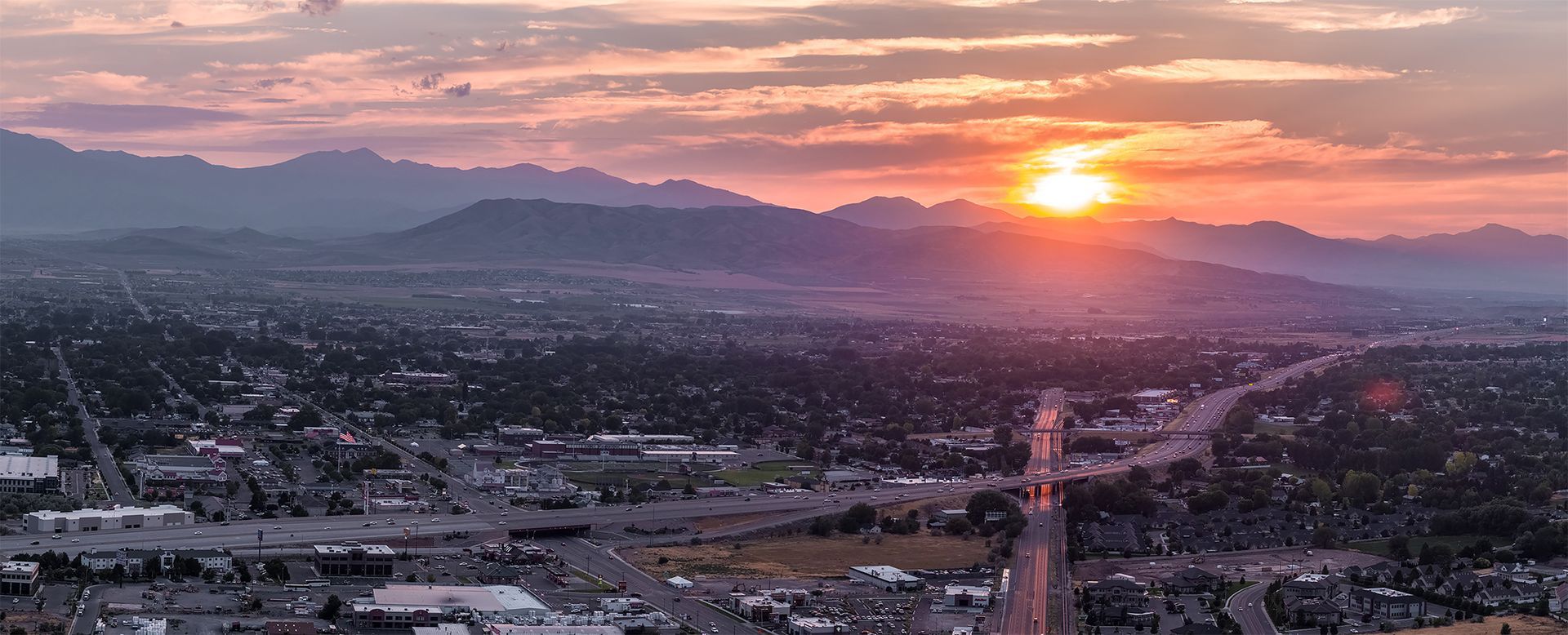
Adobe’s 680,000 SF Lehi Campus is an iconic project in Lehi that was completed in two phases, with the first phase opening at the beginning of 2013 and signaling a new era of development along the Silicon Slopes corridor. (photo by Dana Sohm) Inset: Aerial view showing an illustration of Texas Instruments’ new 300 mm semiconductor wafer manufacturing plant—referred to as “LFAB2”—which broke ground last November and marks the single largest investment (over $11 billion) in state history. (photo courtesy Texas Instruments)

Work continues to grind forward on the mammoth new Salt Lake City Water Reclamation Facility (WRF)—a critical $850 million project being built by a joint venture of the Salt Lake regional offices of Sundt Construction and PCL Construction that will replace the current facility in North Salt Lake once it's turned over to SLC's Department of Utilities (SLCDPU) in July 2026. As it stands, this is the second-largest project in City history, trailing only the recent $2 billion-plus Salt Lake International Airport Redevelopment (Phases 3-4 ongoing), and one of the most technically challenging projects in the state. "We are up for the challenge every day—the magnitude of this thing is unreal," said Manny Diaz, Project Manager for Salt Lake-based Sundt, as he drove around the massive 30-acre site in late-January, a worksite teeming with 300 current employees (it will peak at 400 workers this summer) and myriad complicated structures being built simultaneously. Diaz is a long-time veteran of the water reclamation facility industry—this project marks plant No. 26 in his own personal history—and he was brought in a year ago by Sundt because of his expertise. When he arrived in Salt Lake at the beginning of last year, it was right smack dab in the middle of what proved to be a record-breaking year for snowfall. "It was quite a welcome to Utah!" Diaz chuckled. "We keep very close tabs on the weather." And while crews haven't been subjected to the same inclement weather this winter, site conditions are still generally wet and muddy, and the difficulties associated with building the various structures are constant. Crews are nearing the halfway mark, so certainly it's a milestone worth acknowledging, even though a mountain of construction is still left to climb. "It's such a huge accomplishment to be this far," said Jason Brown, Deputy Director of Public Utilities for SLC. "We've faced a lot of challenges, Covid, material shortages [...] it's amazing to be part of a team that works so well together. We still have a long way to go, but we'll get there. We've made a lot of progress and should be proud, but it's hard to celebrate success with so much work still ahead." Diaz, along with PCL Project Manager Shayne Waldron, said crews recently achieved a major milestone: one million hours worked, a notable accomplishment. “Achieving the ‘one million hours worked’ milestone is a testament to the coordination and collaboration required of a project this size," said Brown, adding that the new WRF project benefits from regular and ongoing staff collaboration, under the watch of Sundt/PCL, designers AECOM and Jacobs, and SLCDPU leadership. “This [milestone] is the culmination of many different efforts,” added Mauricio Ramos, District Manager for PCL’s Civil Infrastructure Division. “From local engineers to pipe layers, journeymen, construction trade workers, foremen, and general laborers, every team member has been instrumental in reaching this benchmark. The collaboration between PCL and Sundt has been a testament to our shared commitment to excellence and innovation.” "Our crews are working together seamlessly to ensure that the final product meets the goals and needs of the community," said Sam Reidy, Senior VP and District Manager for Sundt. "Celebrating this milestone recognizes the hard work and commitment each member of the project team has made to this project and the Sundt/PCL partnership." Diaz and Waldron said soil conditions challenged the team right out of the gate and took significant time to stabilize the site. "At the very beginning, the project was designed to be built on top of where the sludge beds were at, but it turns out the sludge beds were on shaky ground," said Diaz. "This whole area is young in age, so it's all soft clays and sands," added Waldron. "Soft clays are compressible, so the big issue is settling. It would have [cost] $80 million in piles to shore it up, and then in between buildings you have all the pipe and utility duct banks, so they would almost need to be built on piles." Waldron said the idea came up to pre-load the whole site, where crews built a flat pad, installed wick drains, then pre-loaded 30 ft. of dirt, with drains going down 125 feet and providing a way for water to be pushed out of the clay. "We had over seven feet of settlement," said Waldron. Crews also set up sophisticated monitoring equipment "to see where ground was settling and what layers were compressing the most. It was really scientific—a lot more than I've seen before." Diaz said it took six months to haul in the fill dirt where it remained in place for eight months, then took another six months to excavate out—close to one million yards of total material. It was an exhaustive process, with an average of 400 trucks per day and close to 500 trucks hauling 18,000 tons on the best day. Having a cohesive, highly collaborative team of designers and construction experts has been a boon to the project schedule. Once completed, Salt Lake City’s new WRF will serve over 200,000 residents as well as those who commute downtown to work or visit Utah's capital. It will replace the City’s current—and only—wastewater treatment facility, which is over 55 years old and near the end of its service life. Maintaining reliable operations at the existing facility while constructing the new WRF nearby has been critical for the project’s success. Since breaking ground in 2019, the project team has completed approximately 65% of structural concrete work as well as soil mitigation, deep foundation work, and the installation of underground utilities. In late January crews began excavating dual 63-in. diameter pipelines, along with a 78-in. effluent pipe that is being hauled one giant piece at a time from Canada, a new type of corrugated HDPE with welded joints that should provide greater durability. All in all, crews will ultimately pour 93,000 CY of concrete and install 22 million pounds of reinforcing steel, along with 89,000 LF of underground pipe ranging in diameter from 1.5-in. to 78-in. "The camaraderie among the team members allows for a very cohesive team," said Diaz. "The only way you can tell who works for who is by the color of the truck. We have a 'one project' mentality. The complexity of the job and being trusted to lead this effort [...] have been [important] for me. It's been a great job so far." Diaz, who said his first wastewater treatment plant was in North Miami Beach in the late 80s right after he graduated from college, hopes to remain in Utah once this job is completed and turned over to the client by mid-2026. “I plan on staying here and continue to work on treatment plants in Utah,” he said. “There’s a lot of work here. We have vast experience, and we have a lot of people who want to be in Utah—it’s a great place to live. Let’s do it!”

It's been more than 45 years (1978) since The Cars released their debut album highlighted by the wildly popular song Good Times Roll, but if there was ever a tune to sum up the general sentiment of local A/E/C professionals regarding Utah's 2024 Economic Outlook, Good Times Roll would be up there. "Our members are expecting another good year," said Joey Gilbert, President/CEO of the 650-member Associated General Contractors (AGC) of Utah. "For our contractors in both the building and highway markets, the outlook is good. Many still have decent backlogs to keep them busy through 2024 and in some cases, even 2025. The public sector is strong, and on the private side, owners are still investing in some big projects." Robert Spendlove, Chief Economist for Salt Lake-based Zions Bank, reported at the AGC's Economic Outlook meeting last November that commercial construction was up 1.6%, while Utah as a whole reported 2.5% growth overall, and believes both will continue to fare well in 2024. "Utah also has one of the lowest unemployment rates in the U.S. [2.5%]; when it gets too low, you get real struggles of labor shortages," he said. "It prevents companies from growing and is one of those defining economic characteristics of this past cycle. If we get above 4-5% we get nervous that it's a sign of a recessionary environment." Spendlove said tailwinds include strong consumer spending, a strong labor market, and an overall robust economic Intermountain West region, while headwinds could include a lack of new workers, government shutdowns, energy prices, and international uncertainty. Another bonus is that Utah remains one of the strongest states economically, regardless of what is happening nationally. "I would say uncomfortably optimistic," countered Dejan Eskic, Senior Research Fellow for the Kem Gardner Policy Institute at the University of Utah, citing a number of factors potentially slowing down the design and construction industry such as housing, labor, and material price fluctuations—basically the same post-Covid headwinds Utah-based firms have been battling the past couple of years. "On paper, we should have a decent economic year in Utah. Because it's an election year, it brings more optimism generally. Stock performance does better in an election year, jobs do better. You have to stick to those basics. Eskic has been with the Gardner Institute for eight years, including the past five in his current role, explained that some of the uncomfortableness facing the local economy stems from having virtually no labor pool in certain segments, including construction—which continues to face a dearth of skilled craftsmen in virtually all subcontractor trades. "We still have red flags," he said, noting concerns with still-high housing costs. "Maybe it's too early to call if we've cracked inflation. 2023 ended up way better than anybody expected—it was supposed to be a recession year, but the recession never came, and the labor market exceeded expectations. "I'm bullish on Utah," he added. "I look at the numbers and how we're going, and we're in a very strong growth pattern with the economy. Things will continue to expand." Indeed, despite nasty rising interest rates that put the brakes on some speculative development projects, Utah-based owners continued to plow ahead on projects, and by-and-large most market segments continued to see a healthy amount of activity as firms set about tackling healthy project backlogs.
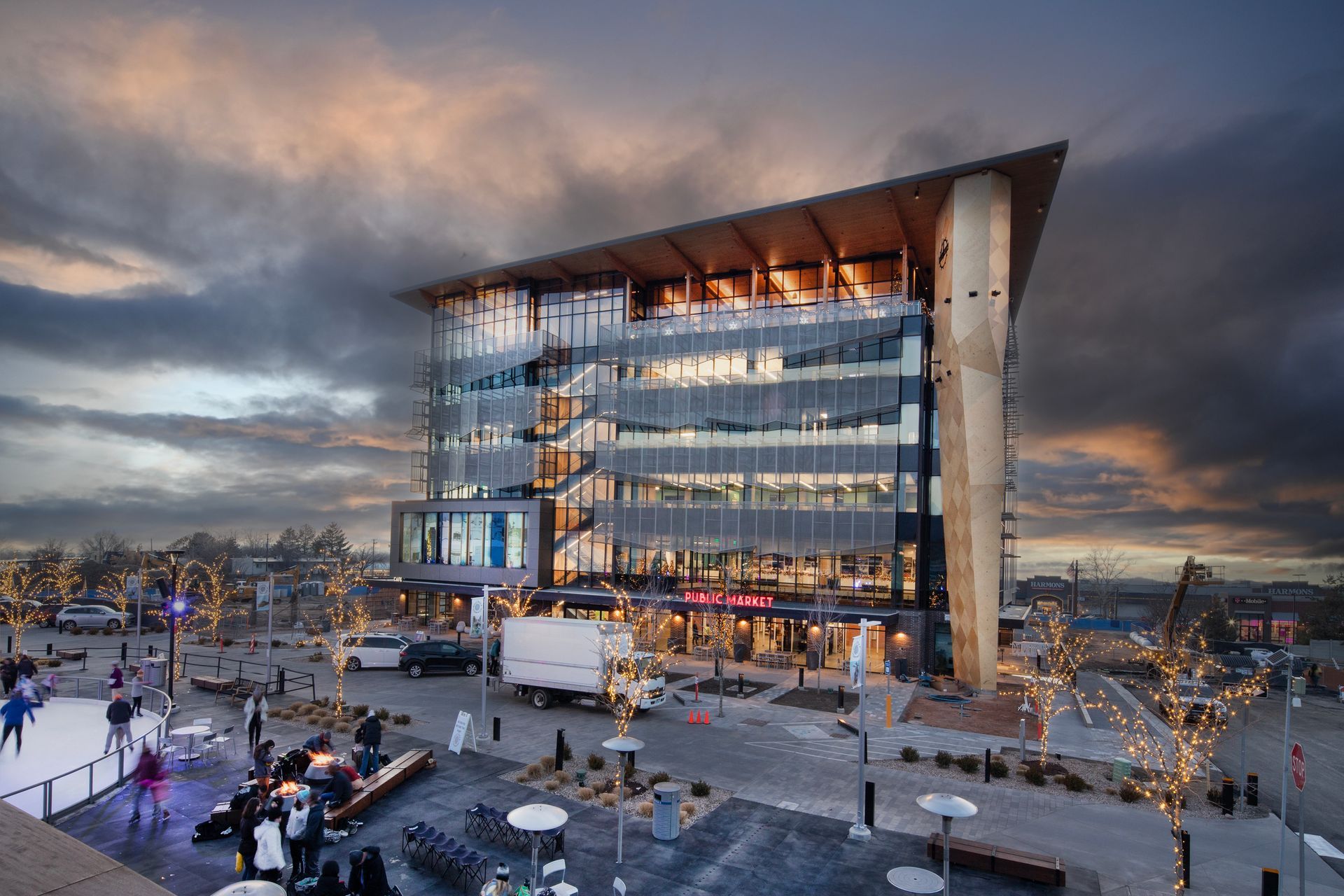
It's been a long time coming for elected officials and the citizens of Millcreek City, but their beloved $45 million, nearly 80,000 SF City Hall is finally complete, ending a lengthy five-year process that tested all parties involved but produced an awe-inspiring six-story building that will serve as the public heart of this rising community southeast of downtown Salt Lake. "It's awesome!" gushed Jeff Silvestrini, in reference to his view as he peered out across the Salt Lake Valley from his fourth-floor corner office, with captivating views via a complex glass curtain wall system highlighted with an intricate, highly functional screen shade. As the only mayor Millcreek City has known during its brief seven-year existence (it was incorporated Dec. 28, 2016), Silvestrini was recently re-elected for another four-year term (he ran unopposed) and has been a driving force behind this new project. "I could see this [view] was going to be amazing when I climbed up the crane when the concrete structure was going up. Standing on the exposed sixth floor before the curtain wall went up, I was humbled at this monumental undertaking for a new city. What we do as a city government is serve the people. We can serve the people much better in a facility like this." Unique Municipal Design Fosters Public Engagement with a "Downtown" Feel Millcreek City Hall builds upon the momentum created by the adjacent Millcreek Common to the east (opened in December 2022) to create an actual "Downtown" or "City Center" space at the bustling area of 3300 South between 1300 East and Highland Drive, which includes a host of exciting new nearby multi-family and mixed-use developments under construction. The project leverages a public-private partnership (PPP) with a local developer on an adjacent shared parking garage, along with the much-needed residential housing. Silvestrini said City leaders "did not contemplate putting City Hall here" initially, but public feedback made it clear residents wanted a downtown area to call their own. Millcreek Common—replete with an ice ribbon, splash pad, and room for food trucks—was planned as a public plaza space and has been wildly popular since its completion in late 2022. Residents also wanted City Hall to have real spaces for the public, not just a strictly-government facility, which provided exciting design opportunities for Salt Lake-based MHTN Architects, which initially worked with City officials in 2017-18 on a City Center Master Plan, which came about via a grant through the Wasatch Front Regional Council, according to Ryan Wallace, Principal-in-Charge for MHTN. "It's located roughly in the geographic center of the community and easily accessed by vehicle, transit, and active transportation—it's something that can unite the community," said Wallace. "The client has created four projects in one," aided by a vertical building mixed-use approach on the narrow footprint, a key to allowing optimum future adjacent development. "We realized early on that there was an opportunity to build a true civic center," added Silvestrini. "The more we thought about it, the more it made sense." The commitment to having a true community building is evident on the first floor, which includes a coffee house, a restaurant, and a flex public market with rotating businesses. "[City leaders] wanted an activating ground floor use that would support their idea of a downtown," said Wallace. "They didn't want City Hall to only be active 8-to-5 and then a dead zone at night." City officials and MHTN staff also drew inspiration on a tour of the new City Hall in Lenexa, Kansas, which includes adjacent common space and a ground floor retail/public market. "Everyone seemed to be thinking on the same wavelength," said Peggy McDonough, MHTN President who served as Project Executive on Millcreek City Hall. "We all felt like this was a completely unique project, unlike any other city hall that we've been a part of, and the second that has a market level. It's being looked at as an example of good development." While level 1 is sure to be a hit with Millcreek residents and visitors over time, levels 2 through 5 showcase the versatility and functionality of the project, with all essential government functions for Millcreek City, along with Unified Police and Community Emergency Response Team (CERT). Unified Police is housed on level 2 and utilizes a one-level sally port/private garage under the building (another bonus of the PPP parking garage). Millcreek City is housed on levels 3-5, with the top floor—level 6—serving as prime community space highlighted by the Grandview community room and its opulent Cross Laminated Timber (CLT) roof that evokes a natural warmth throughout the space.
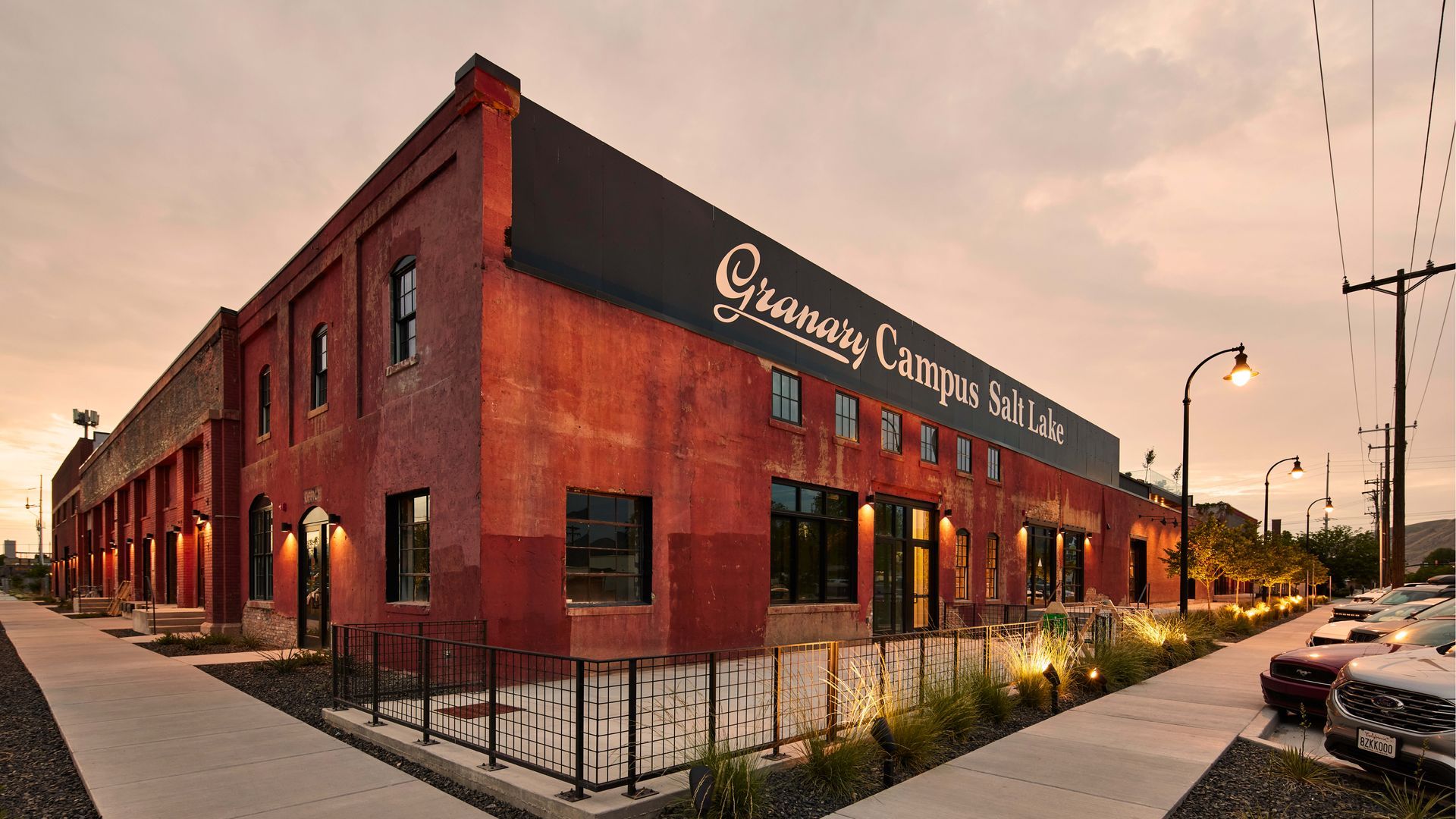
For the first time in its 103-year history, The Utah Chapter of the American Institute of Architects (AIA Utah) has a fully female executive leadership team. It wasn’t intentional, as Past-President Jessica Hoffman stated, “That is who stepped up.” And more importantly, these women have an aggressive plan for serving the entire, very diverse, association. "I'm very excited—we have a great team!" said Chamonix Larsen, Salt Lake City/Denver Department Manager for Morrison Hirschfield, who will serve as 2024 President. "They are all very passionate about what they do, and how architecture can make positive changes in our community." AIA Utah also has a new Executive Director, with Angie Harris Roberts coming on board last spring in a part-time role that transitioned to full-time in October. She is charged with overseeing industry legislation and streamlining AIA services such as providing standard contract documents, sponsoring educational events, and hosting conferences that communicate new design ideas, technologies, and initiatives. Larsen has targeted adding value to members and increasing public outreach scope as her focus for the upcoming year. One particularly exciting (and needed) project proposes a mentorship program that utilizes the talents of the AIA fellows and partnering organizations. The staff and board have applied for a grant and approached local firms for matching funds to build a long-term, multi-generational program, that assists mentees to achieve licensure faster and stay in the profession. Working through the Young Architects Forum and the American Institute of Architects Students, the program will enlist the talents of Utah AIA Fellows, the National Organization of Minority Architects, and Women in Architecture, connecting seasoned architects with emerging professionals. They will answer questions and give guidance and counsel on matters ranging beyond making design decisions and locating answers to technical questions, to how to craft career paths and find professional satisfaction. "We've been through some changes, and having a new executive director is exciting as well," added Larsen. "Coming out of the pandemic, it's been about reconnecting with everybody and improving our organizational excellence. It's important to me that we run as efficiently as possible, given that we rely on volunteers. We have an opportunity to dive into what firms need, and how we can better serve our members." Larsen addressed staffing, having access to quality talent, and attracting more skilled architects to the state as key topics. The outlook for Utah remains solid, she said, albeit with some tempered expectations in some markets (multi-family, industrial) which may see projects put on hold until interest rates soften. Utah's continued growth, steady economy, and the prospect of another Salt Lake Winter Olympics raises optimism for the foreseeable future. Leadership is also committed to helping sister organizations with programs aimed at stimulating interest in architecture from outside the industry and providing a pipeline of talent from a diversity of backgrounds into the industry. This includes encouraging programs in elementary schools to educate children about the role of architecture in a community, collaborating on youth mentoring events, and fostering NOMA’s effort to bring architects from underrepresented groups into the College of Fellows. 2024 AIA Utah Leadership President – Chamonix Larsen, AIA is an experienced architect with a diverse professional background with 20+ years of experience including building envelope consulting, architectural design, technical design lead, project management, owner’s representative, and commissioning authority. She joined Morrison Hershfield’s Building Science Division in 2017 and manages building envelope consulting teams in Salt Lake and Denver. While at the State of Utah, Larsen oversaw the development and implementation of the DFCM's High Performance Building Standard and state-wide operational sustainability efforts. She is also an adjunct professor at the University of Utah College of Architecture and Planning. President Elect – Whitney Ward, AIA, LEED AP is a Principal at Salt Lake-based VCBO Architecture and has been with the firm since 2007. Ward embraces a holistic design approach and is an advocate for both community engagement and sustainable design. She also teaches Sustainable Development as an Adjunct Professor with the University of Utah City and Metropolitan Planning Department. Secretary – Natalie Shutts-Bank, AIA, RIBA is an experienced architect who thrives when navigating between the vastness of all creative possibilities and the real-world constraints of any design problem. She has worked multiple design typologies at a range of scales on higher education, civic, hospitality, healthcare, and large-scale residential projects. Treasurer – Libby Haslam, AIA, RIBA, LEED AP, NCARB is the founder of Studio Long Playing, an architectural firm that practices many typologies of spaces. The firm’s current focus is on higher education. Studio LP is also engaged in restaurant design and residential work, with the intent for collaboration with different artisans and art forms. She has been teaching studio as an Associate Professor (career-line) at the University of Utah School of Architecture since graduating from the U in 2001For the first time in its 103-year history, The Utah Chapter of the American Institute of Architects (AIA Utah) has a fully female executive leadership team. It wasn’t intentional, as Past-President Jessica Hoffman stated, “That is who stepped up.” And more importantly, these women have an aggressive plan for serving the entire, very diverse, association. "I'm very excited—we have a great team!" said Chamonix Larsen, Salt Lake City/Denver Department Manager for Morrison Hirschfield, who will serve as 2024 President. "They are all very passionate about what they do, and how architecture can make positive changes in our community."
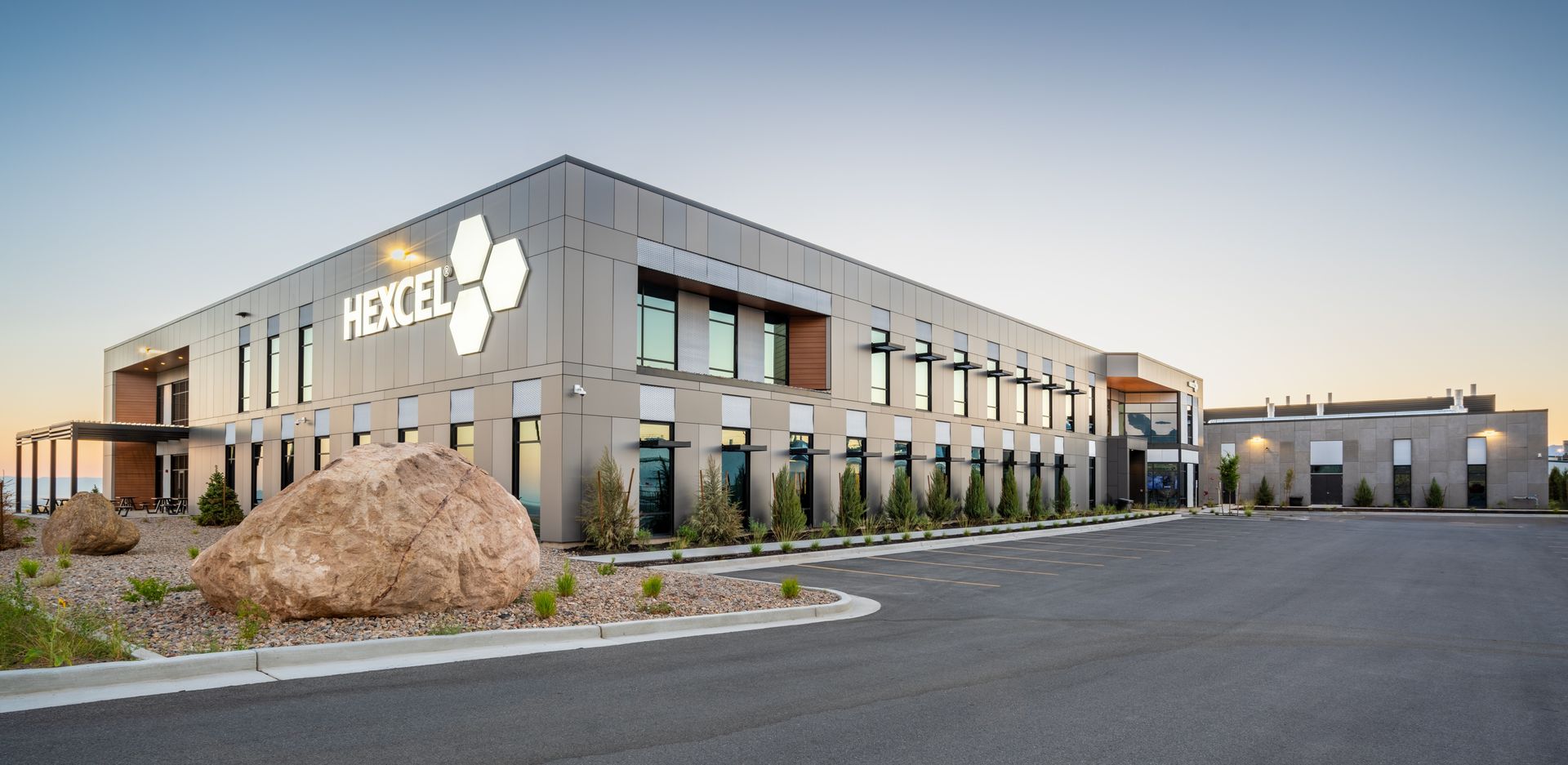
The days of the commercial industrial market consisting primarily of boring, staid (read: ugly) warehouse and manufacturing buildings are long gone, as employee-conscious corporations and forward-thinking real estate developers have been realizing the value of housing employees in spaces that sizzle with stylish interior designs with loads of on-site amenities. Hexcel Corporation did just that with the design of its most significant recent project in West Valley City, a $34 million, 105,000-SF facility dubbed the Center of Research & Technology Excellence, which includes the largest high-performance carbon fiber manufacturing plant in the world, along with housing Hexcel's aerospace matrix operations. The center is "designed to encourage and inspire our team to dream big and ensure that our customers are awarded the strongest, lightest weight, most durable advanced composites that the world has ever seen," said Nick Stanage, Hexcel Chairman, CEO and President. He said that when the Center opens, “you will be surrounded by everything it means to be a leader in advanced composites technology. You will see high-tech labs and cutting-edge research and testing equipment. Our lobby will showcase advancements and innovations that are propelling the future in commercial aerospace, space and defense, and industrial markets.” Sharp aesthetics and providing optimum working conditions are a must for employers in a market with a current state unemployment average hovering just over 2% and in a society where the workforce is increasingly opting to work remote (at home) either full-time, or with a hybrid/flex schedule. The primary objective of the facility is to serve as a catalyst for research and development in advanced composite technology, with a specific focus on aerospace, space, defense, and industrial applications. According to Mike Phillips, VP of Project Development at R&O Construction's Salt Lake office, the fast-track design-build seamlessly blended a tilt-up laboratory with a two-story Class A office building, illustrating the owner's attention to high quality and optimum design. "The entire team was focused on schedule and cost throughout the process, while meeting owner's requirements and needs. It was a very successful project." The facility's design transcends conventional manufacturing and research spaces. Instead of a stark separation between these functions, the building integrates both—fostering an environment where scientists and production personnel can collaborate seamlessly. This approach underscores Hexcel's commitment to innovation and how diverse functions can coexist within the same space. One of the project's most noteworthy contributions lies in its commitment to sustainability. Hexcel actively recycles carbon fiber prepreg composite cutoffs to produce composite panels that find applications in commercial markets. By upcycling and repurposing materials, the project demonstrates a forward-thinking approach to resource utilization and waste reduction. In a resourceful move, the tilt panels were utilized as the crane path to avoid potential soil issues. This approach was executed after thorough consultation with engineers, resulting in a seamless process with all panels standing within a short timeframe, without any compromise to structural integrity or aesthetic appeal. Exterior Trespa panels were strategically oriented to create a dynamic carbon checkerboard pattern, aligning with the aesthetic of Hexcel's innovative products. This deliberate choice not only showcases a visually striking design element but also reflects the company's commitment to excellence in composite materials. Tilt-up panels underwent a meticulous sandblasting process to enhance their carbon-like appearance. This technique, applied after curing and installation, contributes to the overall visual effect and reinforces the project's dedication to craftsmanship.








